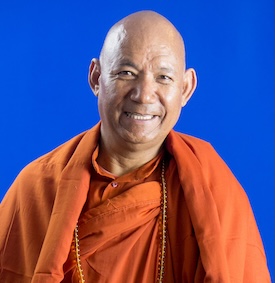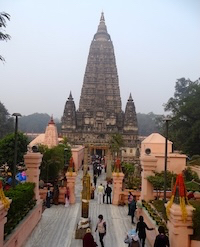Viewpoint by Bhikkhu Sanghasena*
LEH, Ladakh, India | 8 March 2025 (IDN) — The ongoing debates surrounding the management of the most sacred place for the Buddhist world, the Mahabodhi Temple in Bodh Gaya, underscore a deeper issue of religious representation and governance in multi-religious India, as the government of Prime Minister Narendra Modi promotes India as the home of Buddhism.
Bodh Gaya holds immense significance for Buddhists globally. However, its governance structure — originally mandating a Hindu majority and later amended to equal Hindu-Buddhist representation — has long been a point of contention.

Many Buddhists argue that they should have full control over the temple’s management, as is the case with other major religious sites in India and abroad.
Built by Emperor Ashoka in the 3rd century BCE, the temple faced destruction following the 12th-century invasions led by Bakhtiyar Khilji of the Ghurid dynasty.
In 1891, Sri Lankan Buddhist leader Anagarika Dharmapala embarked on a pilgrimage to the recently restored Mahabodhi Temple, only to be shocked by what he encountered. The temple was under the control of a Saivite priest, the Buddha’s image had been transformed into a Hindu icon, and Buddhists were barred from worshiping at their own sacred site.
Deeply disturbed, he initiated a movement for Buddhist reclamation of the temple, leading a tireless campaign for its restoration to Buddhist hands.
His relentless efforts and appeals eventually led the Government of India to form a new management committee, granting four seats to Buddhist representatives — under the Mahabodhi Temple Management Act, 1949.
Recognizing its immense historical, religious, and cultural significance, UNESCO designated the Mahabodhi Temple as a World Heritage Site in 2002, further cementing its status as one of the most revered Buddhist pilgrimage destinations.
The continued presence of Hindu authorities in its administration is often justified by historical circumstances, particularly the role played by local Hindu caretakers in preserving the temple when Buddhist influence in India had waned. While this contribution is acknowledged with gratitude, Buddhism in India has witnessed a revival due to the efforts of various reformers, including Anagarika Dharmapala, Dr. Bhimrao Ambedkar, and my teacher, Most Venerable Acharya Buddharakkhita, among others.
Today, Buddhists worldwide possess the capacity and resources to manage their sacred site. With Buddhism experiencing a resurgence, the argument that non-Buddhists should continue overseeing the temple’s administration appears increasingly outdated.
A fundamental concern is the lack of Buddhist autonomy in managing their most revered pilgrimage site. Precedents from other religious institutions in India —such as the Ram Mandir for Hindus and Jama Masjid for Muslims — clearly show that places of worship are typically governed by their respective religious communities.
Given this, the demand for exclusive Buddhist control over the Mahabodhi Temple is both reasonable and justified. Recent protests, hunger strikes, and petitions by Buddhist organizations nationwide highlight the growing urgency of addressing this issue.
India, as the birthplace of Buddhism, has a unique responsibility to preserve and honor its Buddhist heritage. The call for Buddhist autonomy at the Mahabodhi Temple is not just about religious governance but also carries significant diplomatic implications.
Prime Minister Narendra Modi has actively leveraged Buddhism as a key aspect of India’s diplomatic outreach, strengthening ties with Buddhist-majority nations such as Sri Lanka, Thailand, Myanmar, Mongolia, Japan, Vietnam, and Bhutan. His participation in key Buddhist events and conferences has reinforced India’s role as a global center for Buddhist heritage.

In 2017, during his visit to Sri Lanka for the International Vesak Day celebrations, PM Modi reaffirmed India’s commitment to preserving Buddhist sites and fostering cultural exchanges. Similarly, India’s hosting of the Global Buddhist Summit 2023, along with his addresses at the International Buddhist Conclave and Dharma-Dhamma Conference, has emphasized India’s dedication to Buddhist cooperation and heritage conservation.
Under Prime Minister Modi’s leadership, significant investments have been made to develop Buddhist pilgrimage circuits, including Bodh Gaya, Sarnath, Kushinagar, and Nalanda. The inauguration of the Kushinagar International Airport in 2021 was a major step to facilitate Buddhist pilgrimages, especially for travelers from Southeast Asia.
India’s engagement with Mongolia, where Buddhism is a key part of national identity, has also been strengthened through cultural and religious diplomacy. PM Modi’s 2015 visit to Mongolia, the first by an Indian Prime Minister, signified the importance of Buddhist ties in bilateral relations.
During diplomatic talks with Thailand, Vietnam, and Bhutan, Buddhist heritage has often been a central theme, reinforcing India’s position as a spiritual and cultural leader in the Buddhist world.
Given India’s diplomatic engagement with Buddhist-majority nations, ensuring Buddhist autonomy at their holiest site would reinforce India’s credibility as a protector of Buddhist heritage.
A viable solution could be the repeal or amendment of the 1949 Act to grant full administrative control to Buddhists while ensuring that the historical Hindu presence in Bodh Gaya is acknowledged with due respect.
Establishing a dedicated Buddhist trust or governing body, with legal safeguards against mismanagement, could provide a balanced and effective alternative to the current system.
Granting full Buddhist administration of the Mahabodhi Temple, while acknowledging its shared historical legacy, would be a significant step toward fairness in religious governance, strengthening India’s cultural and diplomatic ties with Buddhist-majority nations.
Addressing this long-standing concern would reinforce India’s commitment to inclusivity, religious harmony, and the preservation of its Buddhist heritage.
*Bhikkhu Sanghasena was born in a remote village in Ladakh and joined the Indian Army in his youth. He left it in 1977 to become a Buddhist monk. A charismatic and highly energetic social and spiritual worker over the years, today, he is an internationally well recognized and respected socially engaged Buddhist leader. [IDN-InDepthNews]
Image: Buddhist pilgrims at Mahabodhi temple. Credit: IDN


